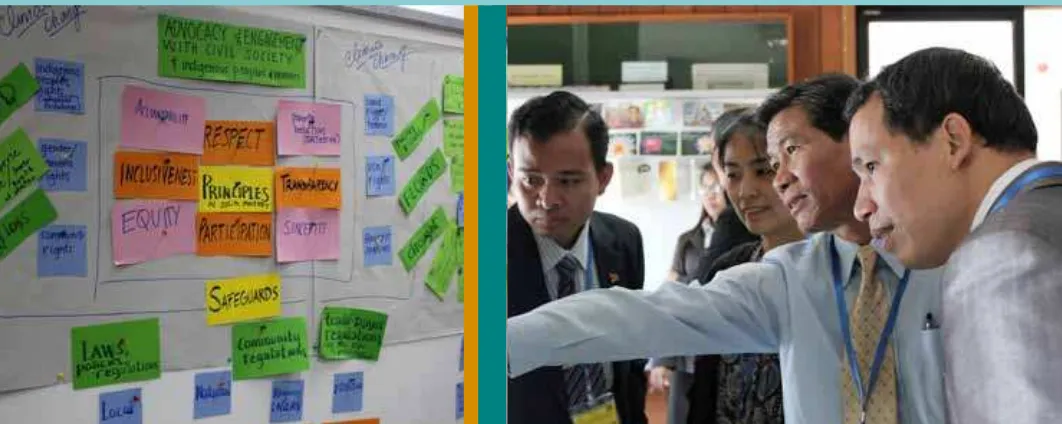Communications & Networking Strategy
The ASEAN Social Forestry Network
In order to more effectively promote social forestry across the Southeast Asia region,
ASFN is developing a communications and networking strategy.
Between November 2010 and January 2011, ASFN Member States and partner
organizations gathered in Bogor, Indonesia, and Bangkok, Thailand, to develop a first
draft strategy.
The ASEAN Social Forestry Network must have a robust communications
and networking strategy to facilitate cooperation and support exchange
between diverse stakeholders.
1 As identified by workshop participants. RECOFTC
facilitated the workshop organized by ASFN Secretariat, with support from SDC, GIZ / ReFOP, ASEAN Secretariat, and the Ministry of Forestry of the Republic of Indonesia.
ASFN recognizes that social forestry is a cost-effective way to do the following:
Support sustainable local livelihoods through income generation
Balance economic use and ecological conservation of forests
Build capacity of forest communities to practice land stewardship and reduce
forest destruction and degradation
Combat illegal logging
Share the benefits from forests among local communities
Build on the inherited potential of local and indigenous communities to
sustainably manage forests
Key Conclusions
Why Are Communication and Networking Priorities?
• Adequate information and knowledge are important to make informed policy
decisions and to promote the scaling up of social forestry best practices.
• Information and knowledge networks can facilitate the learning process and
build relationships across a range of stakeholders to achieve social forestry goals.
•Communicatingandnetworkingexpandstakeholderparticipationinthesustainable
management of forests.
Proposed Strategy
ASFN’s proposed communications and networking strategy supports the network’s larger objectives to contribute to food security and climate change mitigation through sustainable, efficient, and effective use of land, forest, and water resources. To achieve this, ASFN will engage audiences that are internal and external to the network. Internal activities will target the ASFN Secretariat, Member States, donors, and partner organizations (Figure 1). External activities, on the other hand, will target a broader group of policy makers, civil society organizations, research institutions, academics, and members of the private sector.
Internal communications and networking facilitate the exchange of experiences and expertise within the ASFN network in order to develop best practices and effective policy. Capacity building events - such as workshops, trainings, exchange visits, and conferences - will ultimately contribute to the refinement of materials for external communications and networking purposes.
The Outlook
ASFN brings devolved forest management and social forestry to prominence at the regional and inter-governmental levels. Engagement at these levels may pose challenges for communications and networking.
Overcoming language barriers within Southeast Asia is a particular concern.
Such barriers affect the accuracy of information and the ability to share knowledge within the network. Accordingly, ASFN will need to enhance writing and public-speaking skills to ensure English language proficiency among network members. Negotiating conflicting interests in forestland use and management among diverse stakeholders will also be a major challenge. Contention over the use of land and forests is a long-standing and
widespreadissue,andaccordingly,requiresheightenedsensitivityfromASFN.
The effective implementation of the ASFN communications and networking strategy will necessitate additional financial and technological resources. Fund-raising and proposal-writing skills will be critical in garnering support. Likewise, ASFN must increase the
sophisticationofitstechnologicalskillsandacquiretheappropriatesoftwareformonitoring
and evaluation purposes. Such improvements in resources will ensure the accuracy and consistency of information and knowledge flowing through the ASFN network.
Figure 1. The ASFN Secretariat coordinates
Tools
Employing multiple communications and networking tools will help tailor messages to relevant parties, ensuring a dynamic exchange of information, views, and interests. For instance, direct contact would be the most useful method to understand the specific demands of local people and communities. Conferences and meetings are ideal platforms through which ASFN Member States and partner organizations can exchange experiences. Alternatively, print media would be more appropriate for reaching a broader audience of policy makers, and social networking would target civil society groups. The strategic use of these tools will help ASFN weave together a wide range of social forestry stakeholders.
About ASFN
The ASEAN Social Forestry Network (ASFN) is the first government-driven social forestry network in Southeast Asia. It was established by ASEAN Senior Officials on Forestry (ASOF) in August 2005. ASFN links policy makers directly with members from civil society, research organizations, academia, and the private sector, as well as experts from relevant fields.
RECOFTC
Directorate of Social Forestry Development Ministry of Forestry of the Republic of Indonesia Manggala Wanabakti Building, Block VII, 4th Floor, Jalan Gatot Subroto Jakarta 10270 Tel +62 21 5703246 ext. 478 | Fax: +62 21 5730136 E-mail: [email protected] Website: www.asfnsec.org
Members shall share their
ideas openly and freely
with the objective of
learning from each other.
Long Ratanakoma, National Community Forestry Program Coordination Committee, Cambodia Swiss Agency for Development and Cooperation SDC
conference exchange visit audiovisuals print media fax
